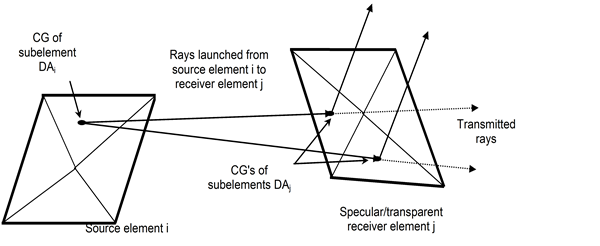Ray-tracing methodology
The following topic describes the thermal solver methodology for handling radiation in the presence of diffuse and transparent/specular surfaces using deterministic ray tracing method.
The thermal solver's approach to handling a combination of diffuse, specular, and transmissive surfaces is to create a single view factor matrix to incorporate all these effects. This matrix is then used to calculate radiative couplings and heat absorption due to diffuse reflections and transmission with matrix methods such as Oppenheim's and Gebhardt's.
Ray-tracing is performed when creating this matrix to account for specular reflection and transmission. Ray-tracing is performed automatically for solar view and heat flux view factors. For planet and orbital view factors to be ray-traced, the planet view factors and albedo factors must be created by explicitly modeling the section of the planet seen by the satellite as a segment of a faceted sphere, and computing the Sun's reflections from the facets. The ray-tracing methodology is summarized as follows:
- If the receiver element j is fully diffuse, no rays are launched, but the standard view factor calculation algorithm is used to determine the strength (magnitude) of the energy incident on j that comes directly from i. This strength value is then stored with element j.
- If the receiver element j is specular or transparent, multiple rays are launched from source elements i to partially/fully specular/transparent receiver elements j.
- Both source and receiver elements are subdivided into sub-elements, and a ray is traced from each sub-element of element i to each sub-element of element j.
- An energy packet for each spectrum (IR and solar) is created which follows the ray. The strength (magnitude) of the energy packet is equal to the area of the launching sub-element view factor between the sub-elements. The strengths of the incident energy packets are stored for each element.
- The rays are traced through multiple reflections and/or transmissions until they encounter a fully diffuse element, and then are not further traced.
- The strengths of the incident energy packets are stored for each element.
- The strengths of the reflected/transmitted energy packets are reduced in magnitude proportional to the absorptivity and diffuse reflectivity of the elements.
- Once all elements are processed, the incident energy packets are summed to calculate the appropriate ray-traced view factors from elements i to j, including all specularly reflected and transmitted effects.

Steps 1 through 6 of the view factor calculation algorithm described above are followed to determine whether the two elements see each other. If element j is specular or transparent, the elements are subdivided as described above, even if there are no shadowing surfaces between them.
